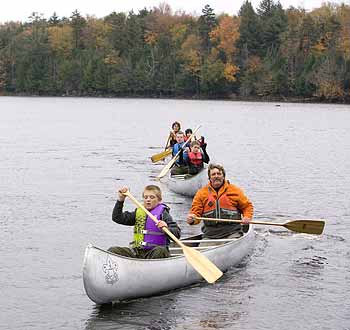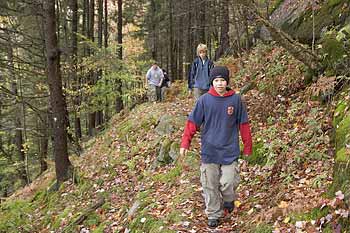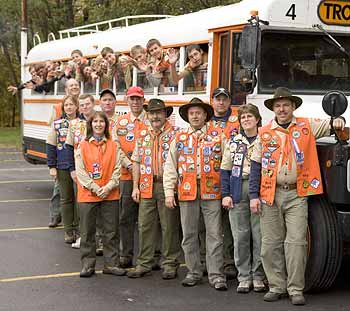'We Go Camping'
By Harold Clapper
Photographs by Tom Sobolik
A New York State troop has conducted an outdoor activity for more than 400 consecutive months (nearly 35 years) by relying on a simple formula of program, planning, and parents.
October in New York State's Adirondack Mountains usually features ideal camping weather—bright, cloudless days, brilliant autumn color, and cool crisp nights. But the weather's failure to cooperate last October didn't faze Troop 709 of Caughdenoy, N.Y., which proceeded as planned, logging its 411th consecutive monthly outdoor event since 1971.
Located north of Syracuse, the hamlet of Caughdenoy has a population of only about 350. But Troop 709—whose members come from other area towns as well—has broad community involvement, a supportive chartered organization in the Caughdenoy United Methodist Church, and committed leaders.
Troop 709's formula for success can be expressed simply: program, planning, and parents.
Program
It's no secret that its dynamic outdoor emphasis is a leading attraction for boys. As Scout Austin Aserian puts it when asked why he joined the troop: "Because it's the best troop around."
"We go camping," sums up Scout Jade Smith, a four-year veteran in the troop. "We have a lot of activities, like canoeing, camping, and mountain climbing. We even camp in the winter."
 Scout Austin Aserian and assistant Scoutmaster Michael LeFlair lead other Troop 709 canoes along the Oswegatchie River. Scout Austin Aserian and assistant Scoutmaster Michael LeFlair lead other Troop 709 canoes along the Oswegatchie River. |
The destination for the 26 Scouts and 16 leaders on the October 2005 outing was the campground at the State University of New York Ranger School at Wanakena, N.Y. (http://rangerschool.esf.edu). Located on 2,800 acres in the state's Adirondack Forest Preserve, the school is a component of the university's School of Environmental Science and Forestry. Its permanent shelters and fireplaces offered the troop a welcome home base for the chilly, rainy weekend.
On its outings Troop 709 usually provides a variety of activities geared to the ages and experiences of different groups of boys. The two-day October outing included seven such options involving hiking and canoeing. (When water is available, canoeing is always an option because the troop owns 12 canoes.)
Older Scouts chose from three canoe-and-hike trips. One featured four miles of canoeing, three miles of hiking, and ended at an overlook with a scenic view of Cranberry Lake, Lows Lake, and the Five Ponds Wilderness.
Another offered a four-mile, relatively flat, easy hiking trail plus about four miles of canoeing, ending at a 20-foot waterfall on the Oswegatchie River.
The third trip had only a half mile of hiking and a short canoe ride and took Scouts to the site of 140-foot-tall, 400-year-old white pine trees. (In addition, Scouts who didn't want to canoe could do only the hiking portion of any combination trip—or choose one of four other trips.)
All canoeing activity was preceded by a review of boating safety (including the proper way to enter, launch, and exit a craft) by assistant Scoutmasters Scott Bendura and Paul Newton Jr., followed by a water safety briefing by Star Scouts Kevin Hamon and Chris LaFlair, who are BSA certified lifeguards.
Planning
The success of Troop 709's outdoor program is due to good planning, much of it done by the boys. And the Scouts are not averse to altering their schedule at the last minute, as they did last winter when the troop learned about an opportunity for rock climbing and cancelled the planned camp-out in favor of the new activity.
 For their weekend trek, Troop 709 Scouts (front to back) Dan Forth, Marc Lapoint, and Kyle Wolff opt for a relatively easy trail—one of several choices based on age and experience. |
The annual program plan, usually developed in the early fall, includes activities, a budget for funding them, and money-earning projects to generate the funds.
Money-earning projects, like chicken barbecues and pancake breakfasts, help pay troop expenses, including program materials and award insignia. Individual Scouts also earn money for summer camp through a "Camp Bucks" program. A portion of the profits from sales of such things as flower bulbs, candy, Christmas wreaths, and popcorn is credited to each Scout's summer camp account.
"The patrol leaders' council comes up with program ideas for the year," says former Scoutmaster Paul Newton. "They then go to their patrol members to find out what they want to do. The adults add direction to the program, [but] we try not to tell boys what to do."
Each monthly event is assigned to one of the troop's 24 assistant Scoutmasters; that person has overall responsibility for the activity weekend. During the outing, even the Scoutmaster reports to the designated Scouter in charge.
Parents
Continued involvement of parents and others is a third contributing element to the success of Troop 709.
Many parents are eager to be involved not only because their sons are members of the troop but also because they themselves were once Scouts in the troop.
For example, Paul Newton is one of three current leaders who were active in the troop as a boy. In fact, his family has had three generations in the troop. His father was an assistant Scoutmaster, and his son earned his Eagle Scout Award while a troop member. (Newton is now a unit commissioner and has received the Silver Beaver Award for distinguished service to youth in the Hiawatha Seaway Council.)
"We are deep in leadership," Scoutmaster Mark O'Mara says. "Most of the assistant Scoutmasters and committee members are parents of Scouts."
O'Mara also credits the troop's chartered organization, the Caughdenoy United Methodist Church, for helping make the troop successful. In addition, the Caughdenoy Volunteer Fire Department and the Red Onion Grocery and Pizzeria often provide support for events.
In addition to two dozen assistant Scoutmasters, the troop has nine committee members. Some serve more than one function, like Kim Wolff, an assistant Scoutmaster and also the chartered organization representative. She has an Eagle Scout son, Josh, and a second son, Kyle, who is a Life Scout on the trail to Eagle.
Another parent, Cheryl Boughton, is still involved even though her Eagle Scout son, John, is now in college.
Parent participation in the early 1990's helped the troop survive a lack of leaders and a decline in membership. O'Mara became an assistant Scoutmaster and persuaded two fathers of Webelos Scouts to become involved before their sons became Boy Scouts.
With 39 members [as of October 2005] the troop is back at "full strength," according to O'Mara. Each year the troop adds another eight to 10 Webelos Scouts, many from the church's Cub Scout Pack 709.
Keeping Troop 709 interesting and fun for boys is an ongoing process, with new activities being added, like whitewater rafting and kayaking.
Last summer, three leaders took the first steps in developing another high adventure experience. With handheld GPS (Global Positioning System) units to guide them most of the way, they made an 18-mile trek from the Ranger School at Wanakena to the Hiawatha Seaway Council's Sabattis Scout Reservation.
The unmarked trail was made even more difficult by fallen trees that remained from damage caused by massive "microburst" thunderstorms that hit the Adirondacks in 1995, but the Scouters completed the trip.
Unlike that trek, Troop 709's trail of program success is clearly marked—by an unbroken string of more than 400 memorable monthly outings.
Freelance writer Harold Clapper lives in Syracuse, N.Y.
Some Troop 709 Camping HighlightsFor nearly 35 years, the annual camping program of Troop 709 has provided Scouts with activities varying from district or council weekend camporees to local overnight camp-outs to canoe trips and other types of high adventure experiences. Many have taken place in the more than 2.6 million acres of New York State's Adirondack Forest Preserve. For other activities, the troop has traveled to historical sites in the Northeast and elsewhere. Here are some highlights: 102...camporees since 1971, at a rate of three (spring, fall, and winter) per year. 54...camping, canoeing, and hiking adventures in the Adirondack Forest Preserve, including some service work on hiking trails. 28...times attending the World Brotherhood Camporee, a yearly event bringing together Canadian and U.S. Scouts at alternating locations in Canada and on Wellesley Island on the St. Lawrence River. 2...first-place awards (canoeing and best overall unit) at the annual West Point Camporee at the U.S. Military Academy. 1...tour of different historic locations, such as the U.S.S. Dwight D. Eisenhower aircraft carrier, the U.S. Navy's base, Norfolk, Va.; Freedom Trail, Boston, Mass.; Wright-Patterson Air Force Base, near Dayton, Ohio; Gettysburg National Military Park, Gettysburg, Pa.; U.S. Naval Academy, Annapolis, Md.; Saratoga Battlefield, Stillwater, N.Y.; Valley Forge, Pa.; Philadelphia (Pa.) Zoo; Niagara Falls, N.Y.—and more. Troop 709 also has 40 acres of land available for its use near Caughdenoy. The troop has built 12 lean-tos and a pavilion on the property. In addition, money-earning projects have enabled the troop to buy 12 canoes that are a major factor when choosing outdoor program activities. Milestones
|
A Belt Totem and Awards Program
Troop 709 has developed a distinctive belt totem and awards program for recognizing participation in activities. • Small beads at the totem top indicate activities like Webelos-to-Scout transition events, camping trips, camporees, and other special occasions. • Large beads hanging on the bottom left indicate membership in the Order of the Arrow, the Arrow of Light Award, a Philmont Scout Ranch experience, a national jamboree, or specific levels of training. • Each bead on the middle string represents six consecutive months of camping. In addition, Scouts receive the following prizes for each consecutive-camping milestone: six months—camping mug and baseball hat; one year—Turk's head neckerchief slide; two years—camping patch; three years—map patch; four years—high adventure patch; five years—belt and buckle; six years—patch and Boy Scout expedition hat; seven years—BSA red wool jacket. • Right string beads indicate outdoor achievements, such as a 50-mile hike, 50-mile canoe trip, or mountain climbing, as well as the troop's Adirondack 46er and Northville-Lake Placid hiking trail awards. In the troop's history, an elite group of individuals has achieved one or both of two awards that indicate special outdoor hiking and climbing accomplishments: • 46er Award (42 Scouts)—For individuals (the first were in 1925) who have climbed the 46 highest mountains in New York State's Adirondack Forest Preserve. • Northville-Lake Placid Trail (12 Scouts)—The 133-mile route, built in 1922 and 1923, follows a generally easy grade and can be hiked in segments. |
Web Exclusive SidebarsThe following sidebars did not appear in the print edition. More Adventure for Older ScoutsTroop 709 has its own high adventure program for older boys that includes whitewater rafting, winter mountain climbing, cross-country skiing, kayaking, and caving. "For our high adventure activities, boys have to be First Class Scouts with two years of experience and at least one summer at Scout camp," explains Scoutmaster Mark O'Mara. Some high adventure trips for older Scouts may be scheduled separately from troop outings or included in the regular monthly program, such as the longer combination hiking and canoeing trips during the October 2005 outing. Memories Are Made of ThisDuring a special weekend in November 2004, Troop 709 capped off its monthly camp-out with a dinner at the Caughdenoy East Side Fire Station celebrating both the troop's 40th anniversary and its 400th consecutive monthly outing. Current and former troop members were invited to describe their favorite camp-out and provide other memories of troop experiences, fellow Scouts, and leaders. Below are a few typical recollections from Troop 709 alumni:
Some Keys to Successful Outdoor ProgrammingBoy Scouting's 76 percent national retention rate of youth members is, according to David Bates, retired associate director of the BSA's national Boy Scout Division, "exceptionally high" and "directly attributable to meaningful outdoor program experiences." The best units "plan and carry out an outdoor activity every month," Bates notes. That means that volunteers, to be most effective, "need to be astute in developing and organizing outdoor programs that are age-appropriate and capture the interest and enthusiasm of today's youth." Bates offers these tips for planning effective outdoor programs:
|
On the WebFor more articles on a variety of troop outdoor programs, equipment, techniques, and training, go to our search page and click "Camping." |
October 2006 Table of Contents
Copyright © 2006 by the Boy Scouts of America. All rights thereunder reserved; anything appearing in Scouting magazine or on its Web site may not be reprinted either wholly or in part without written permission. Because of freedom given authors, opinions may not reflect official concurrence.
